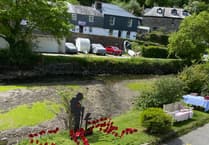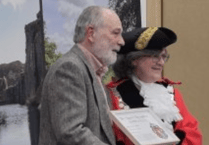THE LIVING history of one of the first social housing schemes in the country has been unveiled at Tavistock Museum.
Two talented young graduates have designed the free summer exhibition at the museum and St Eustaschius Church, which gives a glimpse through the keyhole at every-day life behind the front doors of the famous Bedford Cottages on Dolvin Road in the town.
Emily Spry, 25, (an artist/designer), and Tilly Barnes, 26, (archaeologist/anthropologist), volunteered to support the project to research the socio-economic history of the cottages. The now Grade-II listed cottages were built by the Duke of Bedford to give his workers improved living conditions during the town’s industrial revolution which created diseased slums with overcrowded conditions.
The two women also got their hands dirty literally digging into the past when they scrambled about on the River Tavy behind the cottages and found remains of people’s domestic lives such as a fire surround and kitchen implements.
The homes were designed to give people more individual space and reduce the spread of disease. The new small-scale ‘garden city’ had gardens and mini-allotments and pig sheds, all to encourage the production of food for health reasons. Today’s interest in gardening competitions and allotments is thought to have originated from this housing.
Tilly, who lives in one of the cottages, said: ‘The exhibition uses real life stories which have been researched by TASS (Tavistock Area Support Services charity) as part of their project which records current residents talking about their memories and second-hand research from the archives. These can be very dramatic and include burglaries and when an explosion from the building of the railway opposite threw blocks of granite sky-high into the roof of one of the cottages.
‘It’s been fascinating reading about these and doing our own research into making the graphics as alike those of the time. We also decided to do our own first-hand research by climbing around the river banks and digging into the stones, we found kitchen utensils and a fire surround, which add to the jigsaw of how people led ordinary lives. It’s the humdrum lives, though .that bring the drama of domestic life into focus. There’s fights and crime and accidents and mystery deaths.
‘In our house, for instance, there was a fight over ownership of cabbages between the greengrocer and the residents Mr and Mrs West. The grocer was fined.’
She said the research found that cottage life reflected today’s covid pandemic: ‘The very concept of the cottages resonates with both of us, the need to avoid a spreading disease with social distancing, fresh air, local homemade produce and the closeness of death with the cemetery just across the road. The same is the case with all the stories, they’re no different from today. We realised that people haven’t changed, with the same disputes and incidents. It looks like we’re going full circle — back in time today with an emphasis on sustainable living and fresh home-grown food.’
Emily’s characterful illustrations bring life to the lives of the Dolvin Road community: ‘We found that the magazines and newspapers of the time loved the sordid and macabre, so my drawings reflect that. The same names come up again and again then and today with Wests, Doidges, Hodges and Glanville. My name Spry is also in the records with one of the garden judges called Spry.’





Comments
This article has no comments yet. Be the first to leave a comment.